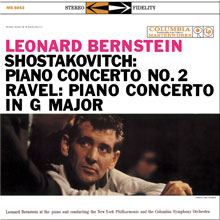Shostakovich & Ravel Piano Concertos - 180-gram LP
Leonard Bernstein, piano and conducting the New York Philharmonic Orchestra
|
CATALOG: IMP6004
|
Side A Side B |
To kick off the new year in 1958, the New York Philharmonic and its music director Leonard Bernstein debuted a new piano concerto by Dimitri Shostakovich. The work, the second of his piano concertos, had been written ten months before for Shostakovitch’s son, Maxim, who was 19 at the time. Bernstein, as pianist and conductor, not only performed the U.S. debut, but on January 6th he recorded the work for Columbia Records. One of the most versatile musicians of the 20th century, Bernstein was a great interpreter of the music of that era. Greatly moved by Shostakovich’s music he was one of the Soviet composer’s greatest champions. The second piano concerto is often referred to as a fiery and youthful work, making it a perfect fit for the mercurial Bernstein. The performance captured here has the same consuming passion we know from his famous recording of Gershwin’s “Rhapsody In Blue.” It may well be the work’s definitive recording. Another work that will forever be associated with Bernstein as both pianist and conductor is Ravel’s Concerto in G. This jazzy and uplifting piece is a perfect playmate for the Shostakovich concerto. No one brought more to this work than Bernstein, who had been playing it with the New York Philharmonic since 1944. Like Ravel, Bernstein was greatly inspired by jazz and it’s clear (especially on this new LP!) that Bernstein understood the mood and syncopation of the piece like few before him. Impex Records’ new LP is a stunning time-capsule for classical record production during the golden era of early stereo: minimally miked, full of natural ambience and incredibly dynamic. The Shostakovich concerto was recorded in the enormous Colorama Ballroom of the Saint George Hotel, the location where Bernstein recorded “Rhapsody In Blue” and Tchaikovsky’s “Romeo And Juliet.” The Ravel was recorded on April 7th, 1958 in the magical acoustics of the 30th Street studio. REVIEWSMichael Fremer, themusicangle.com, December 1, 2011You'll never confuse Shostakovich's Piano Concerto No. 2 composed in 1957 with piano concertos composed during the romantic era, except when you get to the squishy center where the composer goes all Rachnaninoff on you. The cinematic first movement sounds both ominous and light-hearted like a Hitchcock chase cene and it's easy to hear how Bernard Herrmann may have been influenced by this rousing first movement. It will get your heart poinding. The second movement has the stamp of Russian gravitas in the opening bars and then softens to the exquisite Rachnaninoff-style melodic line from which Bernstein pulls all of the emotional longing and heart-tugging beauty. The third movement returns to the angular, chase-like motif of the first and ends with a rousing finale. Bernstein performed and conducted the American debut of the piece, and recorded it in January of 1958 in the Colorama Ballroom of the Saint George Hotel, the site of his iconic recording of "Rhapsody In Blue." Ravel wrote his Piano Concerto in G Major years after Gershwin wrote "Rhapsody In Blue" in 1924, so when you immediately recognize Gershwin in Ravel's piece, know that Ravel wrote his piece in 1931. After writing "Rhapsody In Blue" Gershwin went to Paris where he asked Ravel for lessons but was turned down becuase Ravel didn't want to possibly ruin his jazzy style. Despite the Gershwinesque opening sections and some jazzy interludes of his own, complete with an ascending clarinet line at one point, the piece quickly becomes easily recognizable as Ravel's as the colors shine through and the impressionistic arrangement yields fantasmagoric images. Both pieces are easily accessible even to the classical music-challenged listener. Even though Columbia was never known as a sound label, particularly compared to RCA, Mercury in America and British Decca and EMI in England (Columbia, unlike the others rarely if ever divulged engineer or recording venue) it did produce its share of sonically superb recordings and this is one of them. The Shostakovich recording has greater ambience and more hall presence because of where it was recorded. The Ravel was recorded in April of 1958 at Columbia's famed 30th Street Studio, a former church, and while it had wonderful ambience for jazz, it couldn't produce the spaciousness of a large hall. Don't expect the deep, vast soundstages found on British Deccas or many RCAs. Instead, this one is relatively closely miked, more like some Mercurys. Bernstein's piano is very nicely recorded and well focused and the orchestra is spread neatly behind. There's more space on the Shostakovich, but both have glorious harmonics and impressive dynamics. Good reissue choice Impex!
|

